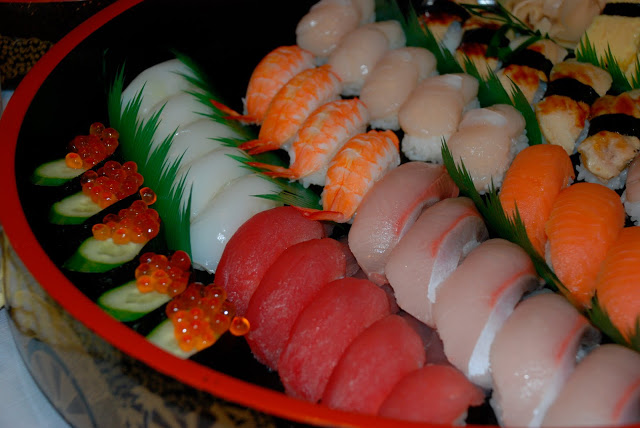Posted on: July 1st, 2010
I am in Japan and on a feeding frenzy! For the last 15 years or so, I’ve used my vacations to travel to and study (ok, pig out on) the world’s finest food cities – and Japan takes the cake! This ancient food culture has many great food styles, but the most recognized by American’s are sushi and sashimi.

Thanks to the deep ocean trench and two ocean currents surrounding these islands (both a warm and cold water current) the selection and freshness of seafood is second to none. It’s this ready availability of impeccably fresh seafood that inspired this newest of all Japanese food styles.
Bincho Maguro – or white tuna – impeccably fresh and fabulously fatty, these amazing fillets are about $7 bucks a pound – less than half the wholesale cost in the US.
Here in Japan, sushi chefs must spend about a decade studying their craft, which includes an intimate knowledge of local seafood, knife skills and proper practices. Apprentices spend their first several years cooking rice alone. This is why I only eat at sushi restaurants with Japanese chefs – they will only use the finest ingredients prepared with the utmost of care and skill – and that is why sushi is so expensive.
Sashimi at a highly respected shop in Motomachi, Yokohama – the lobster is still alive and our chef was in her 80’s.
As a guest, it is an honor to the chef if you understand a few basics about enjoying sushi. Here are a few classic American mistakes. 1) Proper sushi should already have the perfect amount of wasabi – don’t put wasabi in your soy sauce! It is an insult to the chef and a sure sign of a rookie! Wasabi is for sashimi only; not nigiri (hand rolls), temaki (larger cones), or maki (rolls) sushi. 2) Gari (pickled ginger) is for freshening the palate between types of sushi or sashimi – don’t put it on your sushi! 3) Sushi is normally dipped into soy sauce immediately before eating. Ideally you should dip only the fish in the sauce so too much soy doesn’t soak into the rice, or just be careful and dab lightly in shoyu (soy sauce). 4) If you struggle with chopsticks, it is fine to use your hands to pick up your sushi.
Take out sushi from the local grocery (about $9 worth here) – better than most of the non-Japanese owned shops in Colorado for a fraction of the price.
As for sushi and sashimi in Colorado, there aren’t many places that get me excited (most are sushi fusion – or should I say con-fusion). For a casual and wallet-friendly experience, I suggest Sushi Kazu on Arapahoe Road at Peoria. Don’t forget to bring your passport wallet if you plan on traveling internationally for sushi adventures! For the ultimate local experience, go to Sushi Den or Izakaya Den (the Kizaki brothers have set local standards for as long as I can remember). There are a few other places that deserve note – such as Iwayama and da Big Kahuna (Hawaiian style). I am sure there are a few more JAPANESE sushi shops, so will keep searching!
Until then, I must get back to study in Japan. Today maybe ramen, robata, soba, teppan, udon, donburi, okinomiyaki, yakiniku??? We shall see! Konnichiwa y’all!






Look at you surrounded by all of that beautiful fresh food! Even though you're fresh seafood paradise you better show your American pride and have a burger on Sunday. 🙂
OH MY GOD!
Actually I almost had a hamburger patty salad for lunch – but opted instead for the eel (a summer classic). Hamburger steaks are big here – they call them Hamburg (after the city) and they are usually smothered in mushroom demi glace or tomato sauce. Oishi desu!